Figure 7.

A model summarizing smooth muscle signaling pathways that are regulated by RGS2 to control uterine artery myogenic tone. Under conditions where RGS2 is absent or deficient, G protein activation by mechanosensation leads to a sustained phospholipase C (PLC)‐mediated Ca2+ release from the sarcoplasmic reticulum (SR), which increases cytosolic Ca2+ concentration and activates Ca2+‐Cam/MLCK‐mediated smooth muscle contraction. High cytosolic Ca2+ due to the absence/deficiency of RGS2 also inhibits SR Ca2+ release via ryanodine receptors (RyR), which normally inhibits contraction by promoting membrane hyperpolarization. Cam, calmodulin; MLCK, myosin light‐chain kinase; BKC a 2+, Ca2+‐activated potassium channel; myosin‐P, phosphorylated myosin.
